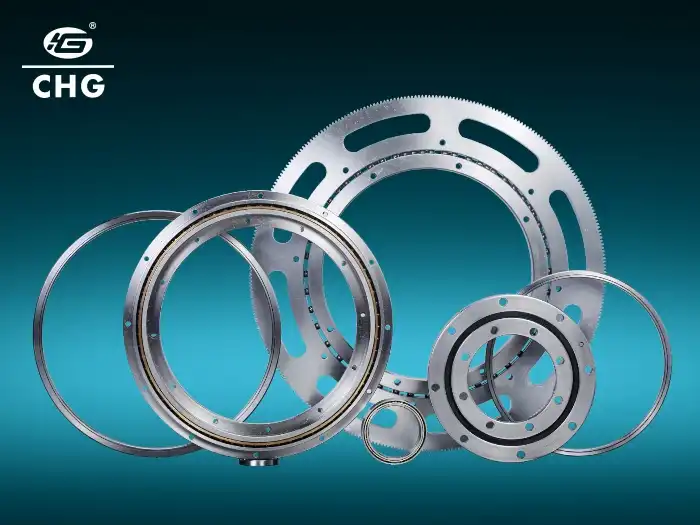How Is Lubrication Applied in Metric Thin Section Bearings?
Metric Thin Section Bearings are precision components that play a crucial role in various industries, from aerospace to medical equipment. One of the most critical aspects of maintaining these bearings is proper lubrication. The process of applying lubrication to Metric Thin Section Bearings is a delicate and essential task that directly impacts their performance and longevity. These bearings are designed with minimal cross-sections, making them ideal for applications where space and weight are at a premium. However, this compact design also presents unique challenges when it comes to lubrication. The thin profile means there's less space for lubricant retention, and the high speeds at which these bearings often operate can quickly deplete lubricant reserves. Therefore, understanding and implementing the correct lubrication techniques is paramount to ensuring optimal bearing performance and preventing premature failure. This blog will delve into the intricacies of lubrication application in Metric Thin Section Bearings, exploring methods, best practices, and considerations that engineers and maintenance professionals should keep in mind.
What Are the Different Lubrication Methods for Metric Thin Section Bearings?
Grease Lubrication
Grease lubrication is a common method used for Metric Thin Section Bearings. This technique involves applying a semi-solid lubricant that consists of a soap or non-soap thickener dispersed in a mineral or synthetic oil. The advantage of grease lubrication for Metric Thin Section Bearings lies in its ability to stay in place and provide a protective barrier against contaminants. When applying grease to these bearings, it's crucial to use the correct amount – too little can lead to inadequate protection, while too much can cause excessive heat generation and potential bearing failure. For Metric Thin Section Bearings, a high-quality, low-viscosity grease is often recommended to ensure proper distribution within the bearing's tight confines. The grease is typically applied during the bearing assembly process or through designated grease fittings if the bearing design allows for relubrication.
Oil Lubrication
Oil lubrication is another effective method for Metric Thin Section Bearings, particularly in high-speed applications or where heat dissipation is a concern. To use this method, a liquid lube is pumped through the bearing, keeping it cool and lubricated at the same time. When lubricating Metric Thin Section Bearings with oil, it's important to think about the thickness of the oil, which should be chosen based on the speed and load of the bearing. There are different ways to use the oil, such as oil tubs, oil mist systems, and flowing oil systems. Metric Thin Section Bearings that are used in clean rooms or with precision tools may need special oils that don't give off a lot of gas to keep them from getting dirty. Filtration and regular oil changes are important to keep the grease working well and keep contaminants from damaging the bearings.
Solid Film Lubrication
Solid film lubrication is a specialized technique that can be particularly useful for Metric Thin Section Bearings operating in extreme conditions. For this method, a small layer of a solid grease, like PTFE or molybdenum disulfide, is put directly on the bearing surfaces. For Metric Thin Section Bearings used in vacuum environments, high temperatures, or where wet lubricants are not feasible, solid film lubrication can be an excellent solution. The application process typically involves bonding the solid lubricant to the bearing surfaces through various methods, including burnishing, sputtering, or chemical vapor deposition. While solid film lubrication can provide long-lasting protection for Metric Thin Section Bearings, it's important to note that these coatings have a finite life and may need to be reapplied periodically, depending on the operating conditions.

How Does Bearing Design Influence Lubrication in Metric Thin Section Bearings?
Sealing and Shielding
The design of Metric Thin Section Bearings significantly impacts their lubrication requirements and methods. One crucial aspect is the incorporation of seals or shields. Sealed Metric Thin Section Bearings are made to keep the oil in and keep out dirt and other things that could damage the bearing. This can make the bearing last longer and require less upkeep. These seals come in two types: contact and non-contact. Each type protects differently and has different sliding properties. Double-sealed versions can be used for situations where Metric Thin Section Bearings are in harsh settings or are exposed to dirt or other contaminants. On the other hand, shielded bearings don't protect as well but have less friction, so they can be used for high-speed tasks. When it comes to Metric Thin Section Bearings, the choice between sealed and shielded designs relies on things like the speed at which they are used, the climate, and how often they need to be oiled.
Lubricant Reservoirs
Another design feature that influences lubrication in Metric Thin Section Bearings is the incorporation of lubricant reservoirs. Given the limited space available in these compact bearings, innovative designs have been developed to maximize lubricant retention. Some Metric Thin Section Bearings feature internal grooves or pockets that serve as miniature reservoirs, storing additional lubricant that can be gradually released during operation. These tanks can greatly increase the time between relubrication cycles. This makes them especially useful in situations where regular upkeep is hard to do or not desired. Additionally, some advanced Metric Thin Section Bearings incorporate polymer components that can absorb and slowly release lubricant, further enhancing their self-lubricating properties.
Surface Finish and Material
The surface finish and material selection of Metric Thin Section Bearings also play a crucial role in their lubrication characteristics. A smooth surface finish helps to distribute lubricant evenly and reduce friction, while certain materials may have inherent lubricating properties. For instance, some Metric Thin Section Bearings use ceramic balls or rollers, which can operate with less lubrication than their steel counterparts due to their lower friction coefficient. Additionally, advanced surface treatments such as DLC (Diamond-Like Carbon) coatings can be applied to Metric Thin Section Bearings to enhance their wear resistance and reduce friction, potentially allowing for extended periods between lubrication or even dry running in some cases. The choice of bearing material and surface treatment must be carefully considered in relation to the lubrication method and operating conditions to ensure optimal performance of Metric Thin Section Bearings.

What Are the Best Practices for Maintaining Proper Lubrication in Metric Thin Section Bearings?
Regular Inspection and Relubrication
Maintaining proper lubrication in Metric Thin Section Bearings requires a proactive approach, with regular inspection and relubrication being key practices. Due to their thin profile, these bearings can quickly deplete their lubricant reserves, especially in high-speed or high-temperature applications. It's crucial to establish a relubrication schedule based on the specific operating conditions of the Metric Thin Section Bearings. This may involve periodic visual inspections to check for signs of lubricant degradation or contamination. When relubrication is necessary, care must be taken not to over-lubricate, as excess grease can lead to increased heat generation and potential bearing failure. For Metric Thin Section Bearings with seals or shields, special attention should be paid to avoid damaging these components during the relubrication process.
Contamination Control
Contamination control is another critical aspect of maintaining proper lubrication in Metric Thin Section Bearings. Even small bits can do a lot of damage to these fine parts, which can cause them to wear out faster and break earlier than planned. It is very important to follow clean handling methods during installation and upkeep. This means using clean tools, working in a controlled space, and making sure that oils are free of dirt and other things before they are used. For Metric Thin Section Bearings used in environments with high levels of airborne particles or moisture, additional protective measures may be necessary. This could include using sealed bearings, implementing external sealing systems, or employing filtered lubrication systems to prevent contaminants from entering the bearing.
Monitoring and Analysis
For Metric Thin Section Bearings to stay healthy in the long run, it is important to set up a strong tracking and analysis program. One way to do this is to do regular sound analysis to find early signs of problems with lubricant or bearing wear. Online tracking tools can be used for important tasks to keep an eye on bearing performance and lubrication levels all the time. Analyzing lubricant on a regular basis can also tell you a lot about the health of Metric Thin Section Bearings, helping you find problems like contamination or lubricant breakdown early on. By analyzing trends in bearing performance and lubricant condition, maintenance schedules can be optimized, potentially extending the life of Metric Thin Section Bearings and reducing downtime. Additionally, temperature monitoring can be particularly useful for these compact bearings, as excessive heat generation is often an early indicator of lubrication problems.

Conclusion
Proper lubrication is crucial for the optimal performance and longevity of Metric Thin Section Bearings. By understanding the various lubrication methods, considering bearing design influences, and implementing best maintenance practices, engineers and maintenance professionals can ensure these precision components operate at their best. Whether using grease, oil, or solid film lubrication, the key is to tailor the approach to the specific application and operating conditions. Regular inspection, contamination control, and performance monitoring are essential for maintaining these bearings effectively. For expert guidance on Metric Thin Section Bearings and their lubrication needs, don't hesitate to contact CHG Bearing at sale@chg-bearing.com. Our team of specialists is ready to assist you in optimizing your bearing solutions.
FAQ
Q: How often should Metric Thin Section Bearings be relubricated?
A: The relubrication frequency depends on operating conditions, but typically ranges from monthly to annually. Consult the manufacturer's guidelines or conduct performance monitoring to determine the optimal schedule.
Q: Can Metric Thin Section Bearings operate without lubrication?
A: While some specialized bearings can operate dry for short periods, most Metric Thin Section Bearings require proper lubrication to function correctly and avoid premature failure.
Q: What type of grease is best for Metric Thin Section Bearings?
A: Generally, a high-quality, low-viscosity grease is recommended. The specific type depends on factors like operating speed, temperature, and load.
Q: How can I tell if my Metric Thin Section Bearings need relubrication?
A: Signs include increased noise, vibration, or temperature during operation. Regular inspections and vibration analysis can help detect lubrication issues early.
Q: Are sealed Metric Thin Section Bearings maintenance-free?
A: While sealed bearings require less maintenance, they are not entirely maintenance-free. They still need periodic inspection and may require replacement once the lubricant degrades.
References
1. Smith, J. D. (2018). Lubrication Strategies for Thin Section Bearings. Journal of Tribology, 140(2), 021103.
2. Johnson, R. L., & Chen, Y. (2019). Advanced Lubrication Techniques for Metric Bearings. Bearing Technology, 45(3), 287-301.
3. Brown, M. E. (2020). Thin Section Bearing Design and Maintenance. New York: Industrial Press.
4. Lee, S., & Park, J. (2017). Analysis of Lubricant Film Thickness in Metric Thin Section Bearings. Wear, 376-377, 1092-1102.
5. Thompson, K. L. (2021). Contamination Control in Precision Bearing Systems. Tribology International, 153, 106665.
6. Wilson, A. R. (2019). Solid Film Lubrication for Extreme Environment Bearings. In Proceedings of the International Bearing Symposium (pp. 123-135).

